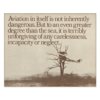But Ron showed some data. Ron, you list numbers of accidents, do you know what the relative fleet size for RV-6 vs. -6A?
Ah, fleet sizes. Had a go-around with a nice guy from Van's recently on that topic. We have some, ummm, differences.
As of January 2019, I show 1,898 RV-6* aircraft on the US registry. By RV-6*, I mean all RV-6 aircraft, irregardless of gear configuration. By "RV-6", I'm referring to any combination of terms that I think might indicate an RV-6: "RV-6," "RV6," "RV 6," "VANS 6." Wild cards are used.
For the -6As, I take the RV-6 list, and look for combination of "6A"..."6A", "6 A", and "6-A."
I get 920 aircraft matching "RV-6A". So the fleet is almost exactly split between known nosewheel aircraft and "other."
And any breakdown as to phase of flight when the accidents occurred?
There are, but what's in the NTSB report is mostly worthless. When I've done the analysis (like for the diagram I posted) I go through and do a manual determination. I.e., read the accident reports, and set the appropriate flag.
But to the extent you can draw any conclusion with such small numbers (you really can't)...
True, but it's the only statistics we have. The RV-6 is the most common single type of homebuilt; if one is going to draw conclusions, it's the baby. My 20-year database (1998-2017) has 227 RV-6 accidents; each accident is less than a half-percent of the total. When I publish formally, I set myself a lower bound for aircraft to include. Usually it's 50... so each accident is a full two percent of the total.
My current project is on fires in homebuilt aircraft...both in flight, and on the ground after crashes. The former is refreshingly rare, but there were 344 instances of the latter. I've analyzed them by construction method, not type. I have the type breakdown (for both in-flight and post-impact) but figure the numbers are too low to be reliable. I don't want a company to get a bad rep based on inadequate data.
... it matches my predictions, more VFR to IFR for the nosewheel, more mechanical problems for the tailwheels. I expected "maneuvering at low altitude" to be higher for the taildraggers, but perhaps the higher pilot time made them more able to pull it off?
Or they're older, and are less likely to take risks. Or a tailwheel is less likely to snag on a wire. Or they're purchasers, not builders, and are out having fun with their "hot rod." There are nine cases of maneuvering at low altitude for RV-4s; seven involved purchased airplanes.
Then again, it's an older design. Most of the RV-4s are probably now owned by someone other than the original builder.
Hopefully, you can see my problem. There are a TON of variables involved. Pilot total time, pilot ratings, pilot time in type, builder vs. purchaser, total time on aircraft, etc, fleet sizes, active aircraft, etc. It's not something that simply boils down where the third wheel is at.
The Van's fleet is indeed big enough to draw conclusions on, but even then, it starts losing validity the more-deeply you get into the aircraft type variations. I just completed an analysis of the accident statistics of the RV fleet. Would have loved to do separate analyses of the RV-7 and RV-8 nosegear vs. taildraggers, but it diluted the results too much for my liking. And there weren't enough RV-3, RV-10, or EAB RV-12 accidents to include, either.
The article is scheduled to appear in the March 2020 issue of KITPLANES.
Ron "Going into hiding on 29 February" Wanttaja



